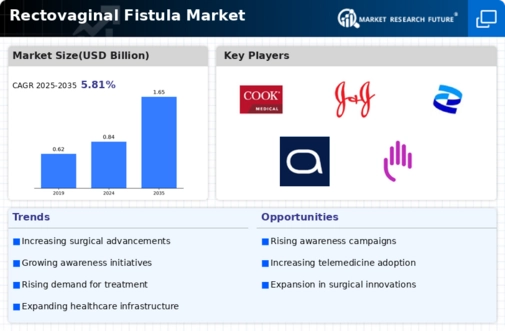Rectovaginal Fistula Size
Rectovaginal Fistula Market Growth Projections and Opportunities
Market Factors of the Rectovaginal Fistula Market
-
Prevalence of Rectovaginal Fistulas: The incidence of rectovaginal fistulas (RVF) is a key factor driving the market. These conditions, which often result from childbirth complications or surgical procedures, have a significant impact on women's health, leading to increased demand for effective treatments and management solutions.
-
Growing Awareness: Increasing awareness about RVF and its treatment options among healthcare professionals and patients is contributing to market growth. Awareness campaigns and educational programs are helping to shed light on the condition, leading to early diagnosis and intervention.
-
Advancements in Medical Technology: Innovations in medical technology, such as improved surgical techniques and new diagnostic tools, are advancing the treatment options available for RVF. These advancements enhance surgical outcomes and reduce recovery times, boosting market growth.
-
Rising Healthcare Expenditure: Increased healthcare spending globally is providing more resources for the development and adoption of advanced treatments for RVF. This trend supports research and development efforts and expands access to high-quality care.
-
Supportive Government Policies: Government initiatives and healthcare policies aimed at improving women's health and funding for research in urological and gynecological conditions are positively influencing the market. Supportive policies help to increase accessibility to treatments and foster innovation.
-
Growing Demand for Minimally Invasive Procedures: The shift towards minimally invasive surgical techniques is a significant market factor. Patients and healthcare providers prefer these procedures due to their benefits, including reduced pain, shorter recovery times, and lower risk of complications.
-
Increasing Number of Surgical Procedures: The rising number of surgical procedures for treating RVF, driven by both elective and emergency cases, contributes to market growth. As the number of surgeries increases, the demand for related medical devices and post-operative care also rises.
-
Expanding Market Players: The presence of numerous market players and manufacturers focusing on RVF treatments is fostering competition and driving innovation. Companies are developing new products and technologies to address various aspects of RVF treatment, expanding market options.
-
Focus on Personalized Medicine: There is a growing emphasis on personalized medicine in the RVF market. Tailoring treatments to individual patient needs and conditions improves outcomes and patient satisfaction, driving demand for customized solutions.
-
Rising Prevalence of Related Conditions: The prevalence of conditions that predispose individuals to RVF, such as pelvic inflammatory disease and chronic constipation, is affecting the market. As these conditions become more common, the need for effective RVF treatments increases.
-
Patient-Centric Approaches: There is an increasing focus on patient-centered care approaches in the healthcare sector. This shift emphasizes understanding and addressing the unique needs of RVF patients, leading to improved treatment options and greater market demand.
-
Global Market Expansion: The RVF market is expanding beyond developed countries to emerging markets. Increased access to healthcare services and rising awareness in these regions are contributing to market growth on a global scale.
These factors collectively shape the Rectovaginal Fistula Market, influencing its dynamics and growth trajectory.









Leave a Comment